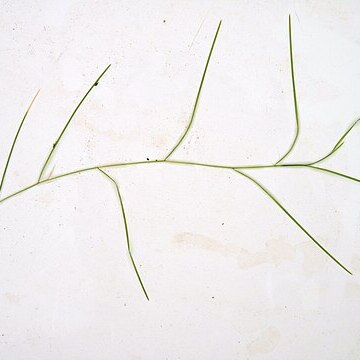Herbs 20-100 cm high from a thin creeping rhizome, forming slender winter-buds. Stems with long internodes below, short above, grooved, producing numerous fairly short side branches above. Leaves dimorphous; submerged leaves alternate, translucent, soft, linear to narrowly linear-lanceolate, 3-7 cm long and 1-3 mm broad, apex acute or acuminate, the area between the midrib and lateral nerves consisting of lacunar, reticulated tissue with larger cells, the lateral nerves becoming faint towards the tip, approaching the midrib gradually; upper floating 'involucral' leaves opposite, just below the flowering spikes, lanceolate to oblong-lanceolate, up to 2 cm long and 5 mm broad, narrowed into a petiole of 1 cm long, thinly coriaceous, not transparent, apple green, with about 7 nerves showing up distinctly below (some leaves showing transitional stages from the submerged to the floating forms); stipular sheaths convolute, small, soon decaying, upper somewhat larger and broader. Spikes small, 25-40 mm long, lengthening during fruiting, whorls 3-7, each whorl usually 2-flowered, scape flattened, slightly thicker above, about 15 mm long. Fruit about 2 mm long and 1.5 mm broad, rounded to oblong in outline, broad-shouldered above, tapered to the base, ventral keel nearly straight, with a central tooth, dorsal keel crenulate ending in a distinct tooth, lateral keels convex ending in teeth near the base, beak fairly long and broad, upturned.
Perennial. Stolons absent or present, thread-like or rhizomatous, terete. Stems 20-100 cm or more long, cylindric with grooves, sparingly to much branched, sometimes developing axillary tubers. Leaves submerged or some floating; stipules axillary, rolled, 4-13 mm long, translucent, decaying early; submerged leaves usually present at time of flowering, sessile, linear to narrowly linear-lanceolate, 2.5-6(-8) cm long, 0.5-2 mm wide (30-75 times as long as wide), bright green to brownish, 3-veined, lateral veins inconspicuous, midrib with broad bands of gas-filled channels along each side, wedge-like at the base, margins entire and flat, tips acute to acuminate; floating leaves with blades usually present, often opposite, petiolate; petiole 3-25 mm long usually shorter than the blade; blades rather leathery, green to brownish, lanceolate to linear-oblong, (0.5-)1-3(-3.7) cm long, 3-11 mm wide, 5-or 7-veined, bases rounded and running into the petiole, margins entire and flat, tips acute; some leaves intermediate between the submerged and floating ones often develop. Peduncles rigid, erect, emergent, 0.9-2 cm long. Spikes usually developing only in the axils of floating leaves, many-flowered, contiguous to shortly distant, 0.5-1.6 mm long in fruit. Drupelets rounded to oblong, 1.5-2.4 mm long; the beak less than 1 mm long and less than half as long as the drupelet, dorsal keel indistinct to distinct.
Plants annual or perennial, in fresh water. Rhizome inconspicuously present or absent. Stems filiform, terete, ca. 0.5 mm in diam., sparsely to densely branched; nodal glands absent; dormant buds axillary, narrowly fusiform, with 1-3 acerose leaves. Leaves dimorphic; stipules axillary, convolute, 4-13 mm, membranous, free from leaf base, decaying early, green or greenish brown when dry. Submerged leaves alternate, sessile, linear to filiform, 2-6 cm × ca. 1 mm, 3-veined, lacunae conspicuous along midvein, midvein not thickened toward leaf base, attenuate toward apex in upper 1/4 of their length, apex acuminate. Floating leaves petiolate, usually alternate, approximately opposite just below peduncle; blade opaque, elliptic or oblong to oblong-ovate, 1.5-2.5 cm × 7-12 mm, leathery, 5-7-veined, base rounded, apex acute or obtuse. Spikes densely flowered, with 4 whorls of opposite flowers; peduncles 1-1.5 cm. Carpels 4. Fruit obovoid, 1.5-2.5 mm, abaxial keel indistinct to distinct, obtuse to minutely undulate-toothed, with a short beak to 0.3 mm. Fl. and fr. May-Oct. 2n = 28.
Vertical shoots short-lived or annual, seasonal; stem filiform, terete, much branched, producing numerous axillary turions; horizontal shoot system poorly developed. Floating leaves present or absent, narrow-elliptic to oblong-elliptic, petiolate, lamina 10-20(-40) by 3-4(-6) mm, 5-7-veined, margin entire, base cuneate, apex acute, petioles 3-12(-20) mm; intermediate leaves often present, petiolate, lanceolate; submerged leaves narrowly linear, sessile, lamina 25-35(-60) by 0.5-0.8(-1) mm, 3-veined, with up to six rows of prominent lacunae, margin entire, apex acute to acuminate; stipules axillary, convolute, 5-10 mm, thinly membranous, acute. Spike cylindrical, contiguous, 5-16 mm; peduncle 9-21 mm. Flowers 7-9, with 4(-5) carpels. Fruits 1.5-2.4 mm, smooth or keeled, with a prominent beak. Stem anatomy: Stele of oblong or circular type. Endodermis of O-type. Interlacunar bundles absent, subepidermal bundles present. Pseudo-hypodermis often absent, rarely 1-layered. Chromosome number: 2n = 28.
Rhizomatous, perennial, aquatic herb, with floating and submerged leaves. Stem terete, to 3 m long; turions not recorded. Stipules convolute, free from base of leaf blade. Submerged leaves sessile, linear, 5–10 cm long, 2–3 mm wide, tapered at apex and base, translucent. Floating leaves petiolate; blade narrowly elliptic, 2–4 cm long,
Perennial herb, up to 1 m high. Leaves submerged but with floating involucral leaves, subtending flower spikes, narrow. Submerged leaves with a well-developed lacunar system bordering midrib. Stipule folded.
Fine submerged leaves and often broader floating ones.
An aquatic


